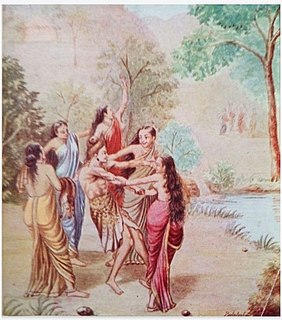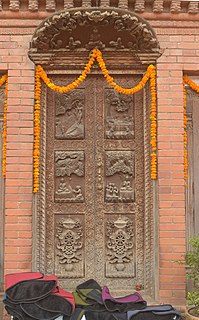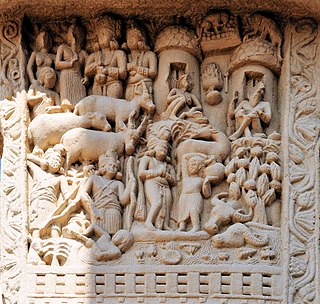
The Ajanta Caves are approximately 30 rock-cut Buddhist cave monuments dating from the 2nd century BCE to about 480 CE in the Aurangabad district of Maharashtra state in India. The caves include paintings and rock-cut sculptures described as among the finest surviving examples of ancient Indian art, particularly expressive paintings that present emotions through gesture, pose and form.
The Jātakas are a voluminous body of literature native to South Asia which mainly concern the previous births of Gautama Buddha in both human and animal form. According to Peter Skilling, this genre is "one of the oldest classes of Buddhist literature." Some of these works are also considered great works of literature in their own right.

The Ramakien is one of Thailand's national epics, derived from the Buddhist Dasaratha Jataka. Basically, it is a Thai version of Hindu epic Ramayana. Ramakien is an important part of the Thai literary canon.

Rishyasringa is a Rishi mentioned in Indian scriptures from the late first millennium BCE. According to the Hindu epics Ramayana and Mahabharata, he was a boy born with the horns of a deer who became a seer and was lured by royal courtesans, which led to the yajna of King Dasharatha. His story also occurs in the Buddhist Jatakas, where he is mentioned as the son of Bodhisatta and was tried to be seduced by royal courtesans.

'Phra Lak Phra Ram' is the national epic of the Lao people, and is the Lao adaptation of the Dasaratha Jataka, a story narrating one of the previous life of Buddha as a Bodhisatta named Rama. It was brought to Laos and other Southeast Asia by propagation of Buddhism. The story reached Laos much later than Cambodia and Thailand (Siam) and thus was affected by local adaptation.

Sharabha or Sarabha is a part-lion and part-bird beast in Hindu history, who is described eight-legged and more powerful than a lion or an elephant, possessing the ability to clear a valley in one jump. In later literature, Sharabha is described as an eight-legged deer.

Śhibi was a king in Hindu texts and the Jataka tales of Buddhism, notably in the Śibi Jataka. Śibi was the son of Ushinara, a famous king of the Chandra Vamsa. He was contemporary to the Suryavanshi King Trayarunya who was the ancestor of Rama. King Śibi was renowned for his liberal beliefs and selflessness and is said to have saved Agni from Indra by offering up his own flesh.

The legendary early Chola kings are recorded history of early Chola rulers of Sangam period in Tamil literature and Sangam literature. The other source of early Chola history is found in the inscriptions left by later Chola kings.

Śakra is the ruler of the Trāyastriṃśa Heaven according to Buddhist cosmology. He is also referred to by the title "Śakra, Lord of the Devas". The name Śakra ("powerful") as an epithet of Indra is found in several verses of the Rigveda.

The position and treatment of animals in Buddhism is important for the light it sheds on Buddhists' perception of their own relation to the natural world, on Buddhist humanitarian concerns in general, and on the relationship between Buddhist theory and Buddhist practice.

The miracles of Gautama Buddha refers to supernatural feats and abilities attributed to Gautama Buddha by the Buddhist scriptures. The feats are mostly attributed to supranormal powers gained through meditation, rather than divine miracles. Supranormal powers the historic Buddha was said to have possessed and exercised include the six higher knowledges (abhiññā): psychic abilities (iddhi-vidhā), clairaudience (dibba-sota), telepathy (ceto-pariya), recollection of one's own past lives (pubbe-nivāsanussati), seeing the past lives and rebirths of others (dibba-cakkhu), and the extinction of mental intoxicants (āsavakkhaya). Miracles found in Mahayana sutras generally play a more direct role in illustrating certain doctrines than miracles found in non-Mahayana Buddhist texts.
Chejarla is a village in Guntur district of the Indian state of Andhra Pradesh. It is located in Nekarikallu mandal of Narasaraopet revenue division.

The legend of The Twelve Sisters or The Twelve Ladies, known as Nang Sip Song (นางสิบสอง) or as Phra Rot Meri (พระรถเมรี) in Thai and រឿងភ្នំនាងកង្រី Puthisen Neang KongRei in Cambodia, a Southeast Asian folktale, and also an apocryphal Jātaka Tale, the Rathasena Jātaka of the Paññāsa Jātaka collection. It is one of the stories of the previous lives of Buddha in which Rathasena, the son of one of the twelve women, is the bodhisattva.

The Vessantara Jātaka is one of the most popular jātakas of Theravada Buddhism. The Vessantara Jātaka tells the story of one of Gautama Buddha's past lives, about a very compassionate and generous prince, Vessantara, who gives away everything he owns, including his children, thereby displaying the virtue of perfect generosity. It is also known as the Great Birth Sermon.

The Tamamushi Shrine is a miniature shrine owned by the Hōryū-ji temple complex of Nara, Japan. Its date of construction is unknown, but estimated to be around the middle of the seventh century. Decorated with rare examples of Asuka-period paintings, it provides important clues to the architecture of the time and has been designated a National Treasure.
Buddhavanam is a tourism project in Nagarjuna Sagar, Telangana created by the Telangana State Tourism Development Corporation. The project was sanctioned by the Government of India viz., Integrated Development of Nagarjunasagar as part of Lower Krishna valley Buddhist circuit with a view to attract large number of domestic and foreign tourists particularly from the South-East Asian countries.

The Buddhist traditions have created and maintained a vast body of mythological literature. The central myth of Buddhism is the life of the Buddha. This is told in relatively realistic terms in the earliest texts, and was soon elaborated into a complex literary mythology. The chief motif of this story, and the most distinctive feature of Buddhist myth, is the Buddha's renunciation: leaving his home and family for a spiritual quest. Alongside this central myth, the traditions contain large numbers of smaller stories, which are usually supposed to convey an ethical or Buddhist teaching. These include the popular Jātakas, folk tales or legends believed to be past lives of Gautama Buddha. Since these are regarded as episodes in the life of the Buddha, they are treated here as “myth”, rather than distinguishing between myth, legend, and folk-tale.

The Syama Jataka or Sama Jataka or Sovannasam Cheadok is the third of the Jataka tales in the collection of Ten Jataka or Mahanipata Jataka, which tell of the last ten lives of the Buddha prior to the life in which he achieves enlightenment. The Syama Jataka tells the story of a Bodhisatva who descends to earth in order to be born as the child of two a pious hermits. As a young man, Sovannasam becomes a hermit as well, and then dedicates himself to the care of his parents who have been blinded. Followers of Buddhism believe that the Buddha told the story in a sermon at Wat Chetapun in order to explain the virtues of Sovannasam's conduct to a monk who was uncertain whether it was appropriate for a monk to take care of his a parents.

The Bhutesvara Yakshis, also spelled Bhutesar Yakshis, are a series of yakshi reliefs on a railing, dating to the 2nd century CE during the time of the Kushan Empire. The reliefs were found in the Bhuteshwar mound, around the remains of a Buddhist stupa, outside Mathura, and are now located in the Indian Museum in Kolkata, with three pillars, and three more pillars and one fragment in the Mathura Museum. They are an important example of Mathura art, of which these and other yakshi figures are "perhaps the best known examples".
The Paññāsa Jātaka, is a non-canonical collection of 50 stories of the Buddha's past lives, originating in mainland Southeast Asia. The stories were based on the style of the Jātakatthavaṇṇanā, but are not from the Pāli Canon itself. The stories outline the Buddha's biography and illustrate his acquisition of the perfections (pāramitā), with a strong focus on generosity (dāna).
















